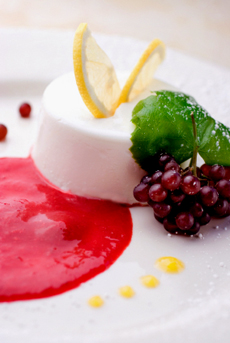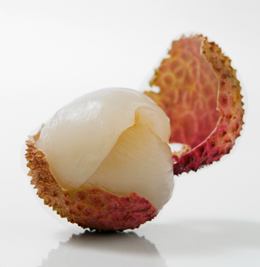

Panna Cotta with raspberry purée, garnished with fresh lemon slice and Champagne grapes. Photo by Kelly Cline | IST.
September 2007
|
 |
Recipe: Lychee Panna Cotta
Exotic Asian Fruit Meets Favorite Italian Dessert
Fresh lychee (pronounced LIE-chee, not LEE-chee) is in season from July through October. Before the season ends, make some delicious lychee desserts. Panna Cotta is a silky and creamy dessert that is simple to make. Panna cotta is very different from crème brûlée. While both are silky-smooth egg custards, panna cotta is much lighter and is served with fruit, whereas crème brûlée’s caramelized, crackly top is the pièce de résistance.
- Crème brûlée, French for “burned custard,” is the richest and thickest of the three classic, silky, baked French custards (crème caramel and pot de crème are the others). All three are made of eggs, sugar, milk and/or cream in different proportions, along with a flavoring such as vanilla. Crème brûlée is made of all heavy cream and egg yolks, and is topped with a brittle layer of caramelized sugar.
- Panna cotta, Italian for “cooked cream,” is a light, silky-smooth egg custard made with heavy cream and gelatin and typically served with fresh fruit or a fruit purée. Panna cotta originated in the Piedmont area of northern Italy, a region known for its cream.
You can read more about the different types of custard in our Custard Glossary.
This recipe is courtesy of Chef Jimmy at the Asian-fusion restaurant Riingo in New York City. It yields 10 to 12 servings, but the number will depend on the size of the dessert dishes or pots de crème you elect to use.
Lychee Purée. The recipe calls for lychee purée, which you can make from fresh lychees, available at Asian food markets. If there’s a Chinatown in your city, you will certainly find them there.
If you’ve only experienced canned lychees, the experience is analogous to canned peaches versus fresh ones. We recommend making this recipe only with fresh lychee or with a fresh-frozen lychee purée like that from A Perfect Purée (it also makes superb cocktails, ice cream and sorbet). Read our full review of A Perfect Purée.
|

A fresh lychee. Photo by A.R. Nowssr | CSP.
|
Ingredients
Preparation
- Mix the gelatin powder with the milk.
- Bring the sugar and the heavy cream to a boil, and pour over the milk mixture. Let the mixture cool, and once completely cool, add the lychee purée and pour into serving cups or dishes.
- Places the cups in the refrigerator until they have set, 3 hours or overnight.
- Garnish the panna cotta with some fresh lychees; if you’re using frozen purée, serve with raspberries or other seasonal fruit or fruit purée, as in the photo at the top of the page. You can also serve the panna cotta with a side of lychee ice cream or sorbet and a shot glass of lychee smoothie: a trio of lychee desserts.
About Lychee
Lychee is a a tropical fruit tree native to southern China. Today it grows throughout southeast Asia, notably in southern Japan, India, Pakistan, north Thailand and Vietnam. More recently, the tasty fruit has been planted in California, Florida and Hawaii, ensuring U.S. fans a more reliable supply.
Like stone fruits (peaches, plums and nectarines), the lychee is a drupe, a fruit that has an outer fleshy part that surrounds a large, hard center seed. It has been called a “lychee nut” because the lychee’s center looks like a glossy brown nut. However, it is inedible and in fact, slightly poisonous.
The typical lychee is about one inch in diameter. The outer covering is a pink-red, roughly-textured rind that is inedible but easily peeled with one’s fingers. The flesh inside is white, translucent and sweet, rich in vitamin C, with a texture somewhat similar to that of a grape. Children liken lychees to “eyeballs.”

|





